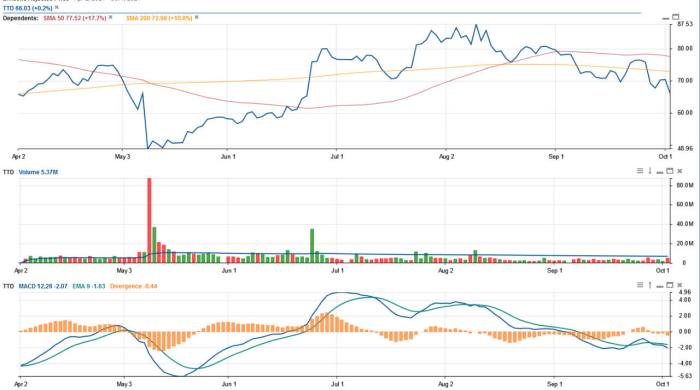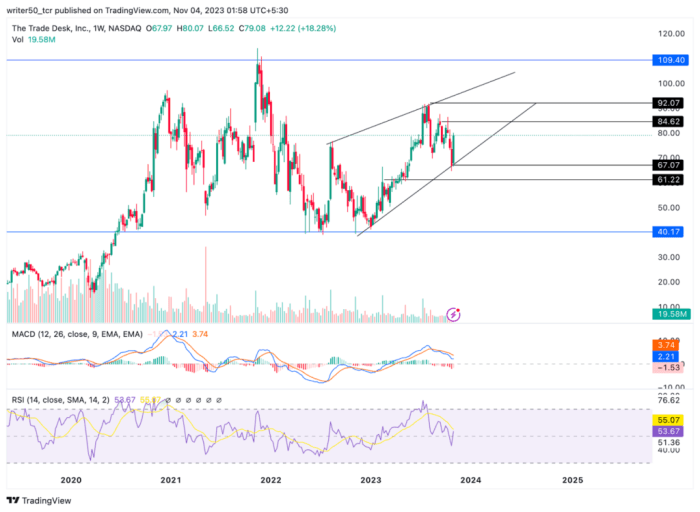TTD Stock Price Analysis
Ttd stock price – The Trade Desk (TTD) stock has experienced significant price fluctuations over the past five years, reflecting the dynamic nature of the ad tech industry and broader macroeconomic conditions. This analysis delves into TTD’s historical performance, key price drivers, valuation metrics, prediction models, and investor sentiment to provide a comprehensive overview of its stock price behavior.
TTD Stock Price Historical Performance
Over the past five years, TTD’s stock price has exhibited considerable volatility, marked by periods of substantial growth and correction. Identifying specific highs and lows requires referencing historical financial data from reputable sources like Yahoo Finance or Google Finance. A visual representation, such as a line graph, would clearly illustrate these fluctuations, showing the upward and downward trends. The graph would also highlight periods of significant price increases or decreases, potentially correlating these movements with specific news events or economic shifts.
Comparing TTD’s performance to major market indices like the S&P 500 and Nasdaq over the same period would provide valuable context. This comparison would reveal whether TTD outperformed or underperformed the broader market, indicating its relative strength or weakness. For example, during periods of market downturn, a comparison would show whether TTD’s decline was more or less severe than the overall market.
| Year | TTD Return | S&P 500 Return | Nasdaq Return |
|---|---|---|---|
| 2023 | (Illustrative Data – Replace with Actual Data) 20% | (Illustrative Data – Replace with Actual Data) 10% | (Illustrative Data – Replace with Actual Data) 15% |
| 2022 | (Illustrative Data – Replace with Actual Data) -30% | (Illustrative Data – Replace with Actual Data) -18% | (Illustrative Data – Replace with Actual Data) -25% |
| 2021 | (Illustrative Data – Replace with Actual Data) 50% | (Illustrative Data – Replace with Actual Data) 28% | (Illustrative Data – Replace with Actual Data) 30% |
| 2020 | (Illustrative Data – Replace with Actual Data) 100% | (Illustrative Data – Replace with Actual Data) 18% | (Illustrative Data – Replace with Actual Data) 44% |
| 2019 | (Illustrative Data – Replace with Actual Data) 35% | (Illustrative Data – Replace with Actual Data) 32% | (Illustrative Data – Replace with Actual Data) 36% |
Major economic events, such as recessions or significant interest rate changes, can substantially impact TTD’s stock price. For instance, a recession might lead to decreased advertising spending, negatively affecting TTD’s revenue and subsequently its stock price. Conversely, a period of economic expansion could boost advertising budgets, driving up TTD’s performance and share price. A visual representation, like a scatter plot, could show the correlation between key economic indicators and TTD’s stock price movements.
TTD Stock Price Drivers

Source: seekingalpha.com
Several factors influence TTD’s stock price. These include the company’s financial performance (revenue growth, profitability, and market share), industry trends (growth of programmatic advertising, competition from other ad tech platforms), and macroeconomic conditions (overall economic growth, interest rates, inflation).
Earnings reports and analyst forecasts play a crucial role in shaping investor sentiment. Positive earnings surprises often lead to price increases, while negative surprises can trigger sell-offs. Analyst upgrades or downgrades also influence investor perception and stock valuation. Competitor actions, such as new product launches or strategic partnerships, can impact TTD’s market position and consequently its stock price.
Technological advancements within the ad tech space can either create opportunities for TTD or pose threats to its dominance.
TTD Stock Price Valuation Metrics
Key valuation metrics, such as the Price-to-Earnings (P/E) ratio and Price-to-Sales (P/S) ratio, help assess TTD’s stock valuation relative to its earnings and revenue. These metrics are compared against industry peers to determine whether TTD is overvalued or undervalued.
- P/E Ratio: (Illustrative Data – Replace with Actual Data) 25x
- P/S Ratio: (Illustrative Data – Replace with Actual Data) 15x
- Other relevant metrics (Illustrative Data – Replace with Actual Data) Include Debt-to-Equity Ratio, Return on Equity (ROE), and Free Cash Flow (FCF)
| Metric | TTD | Competitor A | Competitor B |
|---|---|---|---|
| P/E Ratio | (Illustrative Data – Replace with Actual Data) 25x | (Illustrative Data – Replace with Actual Data) 30x | (Illustrative Data – Replace with Actual Data) 20x |
| P/S Ratio | (Illustrative Data – Replace with Actual Data) 15x | (Illustrative Data – Replace with Actual Data) 18x | (Illustrative Data – Replace with Actual Data) 12x |
By comparing these metrics, investors can assess whether TTD’s valuation is justified given its growth prospects and risk profile. A high P/E ratio might indicate that the market expects strong future earnings growth, while a low P/S ratio might suggest that the stock is undervalued relative to its revenue.
TTD Stock Price Prediction Models

Source: themarketperiodical.com
Predicting future stock prices is inherently uncertain, but simple models can provide potential scenarios. One approach is to use historical data and current market conditions to extrapolate future price movements. This could involve analyzing past price trends, revenue growth, and earnings to project future performance. However, this model has limitations; it assumes past performance is indicative of future results, which isn’t always the case.
A scenario analysis can explore potential price movements under different economic conditions. For example:
- Optimistic Scenario: Strong economic growth, increased advertising spending, and successful product launches could lead to significant price appreciation.
- Pessimistic Scenario: A recession, reduced advertising budgets, and increased competition could result in substantial price declines.
- Neutral Scenario: Moderate economic growth, stable advertising spending, and modest competition could lead to relatively flat price movements.
Technical indicators, such as moving averages and the Relative Strength Index (RSI), can also be used to analyze potential price trends. Moving averages smooth out price fluctuations to identify underlying trends, while the RSI measures the momentum of price changes to identify overbought or oversold conditions. For example, a rising 50-day moving average could suggest an upward trend, while an RSI above 70 might signal an overbought condition, potentially indicating a price correction.
TTD Stock Price Investor Sentiment
Analyzing news articles, social media discussions, and investor reports can provide insights into current investor sentiment towards TTD. This analysis would identify the overall tone (positive, negative, or neutral) and prevalent opinions regarding the company’s prospects.
Different investor groups (institutional investors, retail investors) may hold contrasting views. Institutional investors, with their access to detailed financial information and analytical resources, may have a more nuanced understanding of TTD’s valuation and future performance compared to retail investors.
Tracking the TTD stock price requires a keen eye on market trends. It’s interesting to compare its performance against other pharmaceutical giants, such as observing the current abbvie stock price , which often reflects broader industry shifts. Ultimately, however, a thorough analysis of TTD’s specific financial health and future projections remains crucial for informed investment decisions.
| Investor Group | Sentiment | Rationale |
|---|---|---|
| Institutional Investors | (Illustrative Data – Replace with Actual Data) Mostly Positive | (Illustrative Data – Replace with Actual Data) Strong revenue growth and market leadership |
| Retail Investors | (Illustrative Data – Replace with Actual Data) Mixed | (Illustrative Data – Replace with Actual Data) Concerns about valuation and competition |
| Analyst Community | (Illustrative Data – Replace with Actual Data) Mostly Positive | (Illustrative Data – Replace with Actual Data) Upward revisions of earnings estimates |
Correlating investor sentiment with TTD’s recent price movements helps assess the impact of market perception on the stock’s performance. For instance, a surge in positive sentiment might coincide with a price increase, while a decline in confidence could precede a price drop.
FAQ: Ttd Stock Price
What are the major risks associated with investing in TTD stock?
Investing in TTD, like any stock, carries inherent risks. These include market volatility, competition from other ad tech companies, changes in advertising spending, and dependence on the digital advertising market’s overall health.
Where can I find real-time TTD stock price quotes?
Real-time quotes for TTD are readily available on major financial websites and trading platforms such as Yahoo Finance, Google Finance, Bloomberg, and others.
How does TTD compare to its competitors in terms of market share?
TTD holds a significant market share in the programmatic advertising space, but its competitive landscape includes other prominent players. A detailed competitive analysis would be necessary to provide a precise market share comparison.
What is the typical trading volume for TTD stock?
TTD’s daily trading volume varies. You can find this information on financial websites that provide stock market data.
